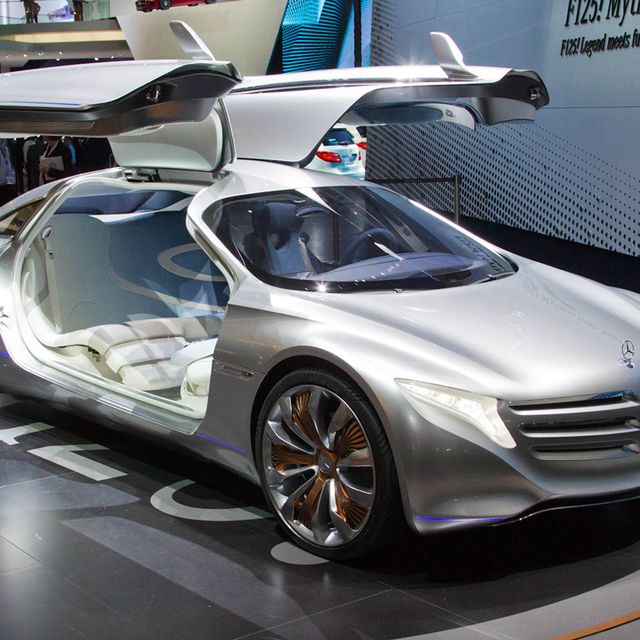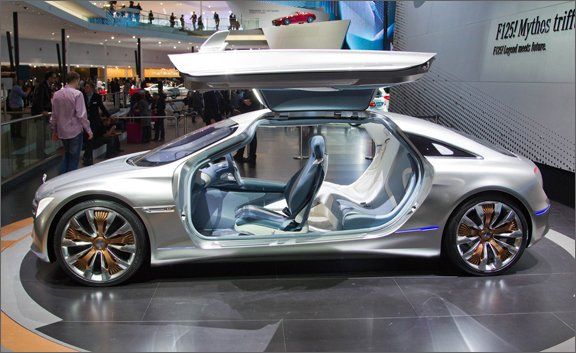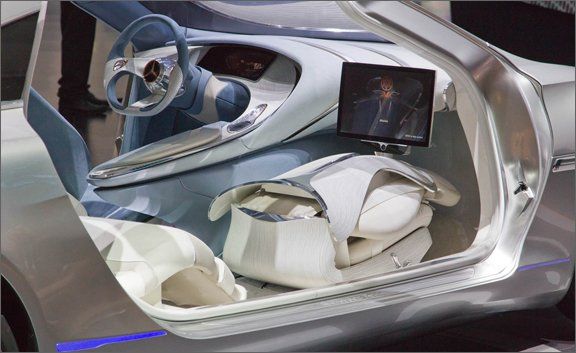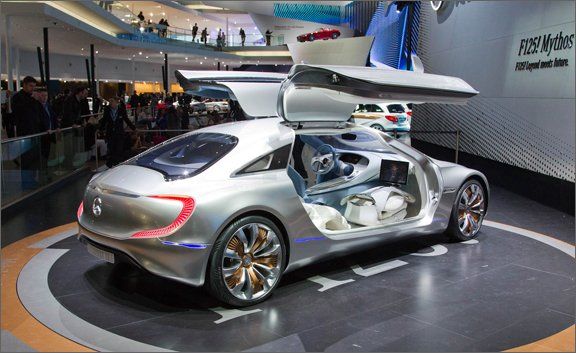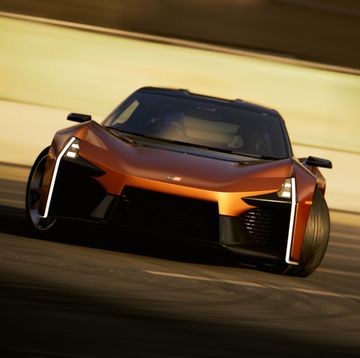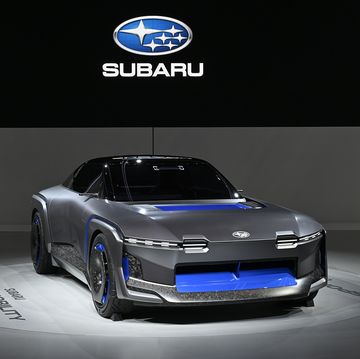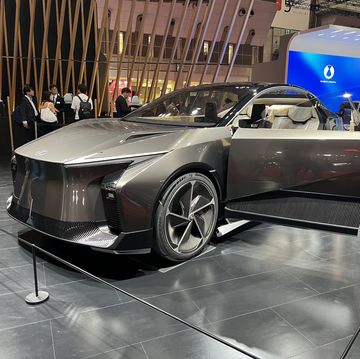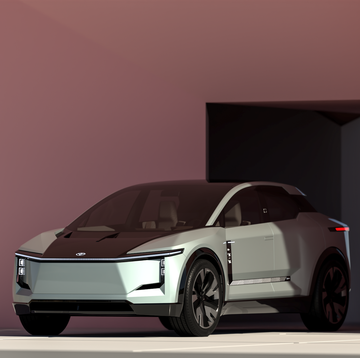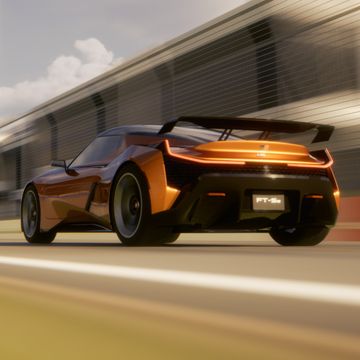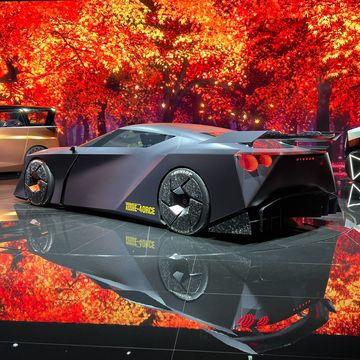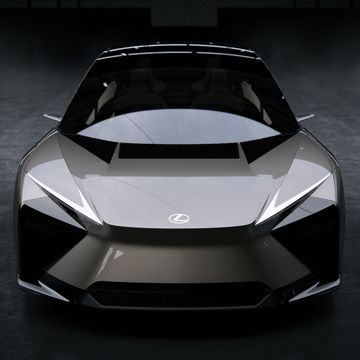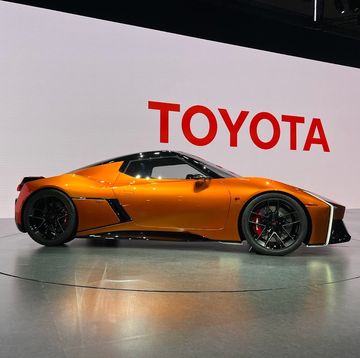This car doesn’t exist yet. Most of its technologies are still under development. It is a construct—more mental than metal—and it exists in the heads of engineers at Daimler’s advanced vehicle engineering in Sindelfingen, Germany, perhaps even more fully than it will exist as a physical, drivable artifact set to be unveiled at this year’s Frankfurt Auto Show.
They call it the F125. The “F” stands for “Forschungsfahrzeug,” or experimental car, and the number refers to the 125th anniversary of the automobile, an occasion celebrated most ardently at Mercedes-Benz. After all, it was the 1886 Benz Patentwagen that came first. The F125 is the Patentwagen’s antipode—a look at how the luxury car might evolve to suit the world circa 2025. It suggests that the pace of evolution will be brisk: The F125 is an electrically driven, hydrogen-fuel-cell–powered, full-size luxury sedan with the range of a diesel, and it is just two model cycles away from the current S-class.
To see the car before its auto-show debut, we went to Sindelfingen near Stuttgart, passed all security gates, and stepped into the most exalted room in Daimler’s research center, the so-called Dom (German for cathedral). It’s very quiet here, very clean, and the walls are an arctic white. The light is artificial; there are no windows. We’re with Gorden Wagener, head of Mercedes-Benz Design, and Herbert Kohler, Daimler vice-president of Research & Advanced Engineering. They are standing next to their vision of the Mercedes S-class’s grandchild.
The F125’s body is 197 inches long, 78 inches wide, and only 56 inches high. More stunningly, it opens via two giant gullwing doors. They are as huge as porch roofs, and they occupy nearly 90 percent of the car’s wheelbase—118 inches cut out of the 131 inches between the axles. Entry into the front and rear is as easy as falling into a recliner—it ought to be; there are no B-pillars in the way.
At first glance, the car looks like a coupe, or at least a hatchback. “No,” says Wagener, “it’s a further development of the sedan shape,” pointing to the three-box configuration and 17-cubic-foot trunk. But the overall envelope, with its low greenhouse, fast roofline, and crouched stance, suggests that the S-class, long the staid burgher of the luxury-sedan world, is about to get seriously sleek. The biggest change may be that, after more than a century, the classic framed grille disappears, replaced by six gill-like slats topped with chrome bars.
As befits the futurism of its shape, the car’s structure and bodywork are a mixture of composite plastics (including carbon fiber), aluminum, and high-strength steel. The body shell itself weighs only 551 pounds, or 40 percent less than that of today’s S-class. Total weight is just 3750 pounds; for comparison’s sake, the current S400 hybrid weighs nearly 850 pounds more.
The interior seats only four. Its driver-oriented cockpit includes 3-D displays, a cloud-based telematics system, and an asymmetrical rear-seating concept. By folding the front-passenger’s seat forward into the footwell, the right-side rear seat can be extended into a business-class chaise, à la Maybach 62. The driver gets his toys, too: Besides voice-controlled systems (navigation, e-mail, internet access), other functions are triggered by hand gestures. Swiping a hand quickly to the right turns on the wipers; pointing a thumb to the right engages the right-hand turn signal; and lifting a hand horizontally raises the temperature. No word yet on what a flip of the ol’ bird will do.
The F125’s proportions suggest rear-drive, but the concept has an electric motor at each wheel comprising what Mercedes calls its e4MATIC system. Even so, outputs denote a rear-wheel bias: The front motors are capable of 67 horsepower and 55 pound-feet of torque apiece, while each rear motor is rated at 134 horses and 148 pound-feet. Peak horsepower is 308; continuous output is 228.
The most interesting F125 technology is its source of electricity. An advanced lithium-sulfur battery is packaged vertically behind the rear seats. With a 10-kWh capacity and an energy density of 159 Watt-hours per pound, this battery beats current lithium-ion mass efficiency by a factor of two. A hydrogen fuel cell located between the front wheels provides the electrical energy needed to maintain the battery’s charge while driving. But instead of storing the hydrogen for the fuel cell as a cryogenic liquid or as a high-pressure gas, it contains the hydrogen within a metal-organic framework (MOF) material. This highly porous crystalline substance has more than 24 million square feet of surface area per pound. When gaseous hydrogen is pumped into the fuel tanks at 435 psi, it’s chemically absorbed by the MOF material in molecular form (H2). Since the size and shape of the MOF storage vessels are flexible, they can be integrated with the F125’s body structure to save space and weight.
Mercedes says the F125 will consume hydrogen at a rate of 2.8 pounds per 100 miles, giving it a range of more than 600 miles. According to Kohler, “The average fuel consumption is equivalent to an 87-mpg diesel.” The small matter of where the hydrogen comes from has yet to be resolved. That, apparently, is what the next 13 years are for.
What has been established is that the future S-class can’t afford to be a slug. Thanks to its reduced weight and linear power delivery, the series-production F125 will need only 4.9 seconds to hit 62 mph from standstill and 3.2 seconds to accelerate from 50 to 75 mph, according to Mercedes.
So here is the company’s vision of the luxury-car future—a veritable chemistry lab hard at work under a body and interior as beautifully crafted and silent as a British gun cabinet. This could get expensive.
